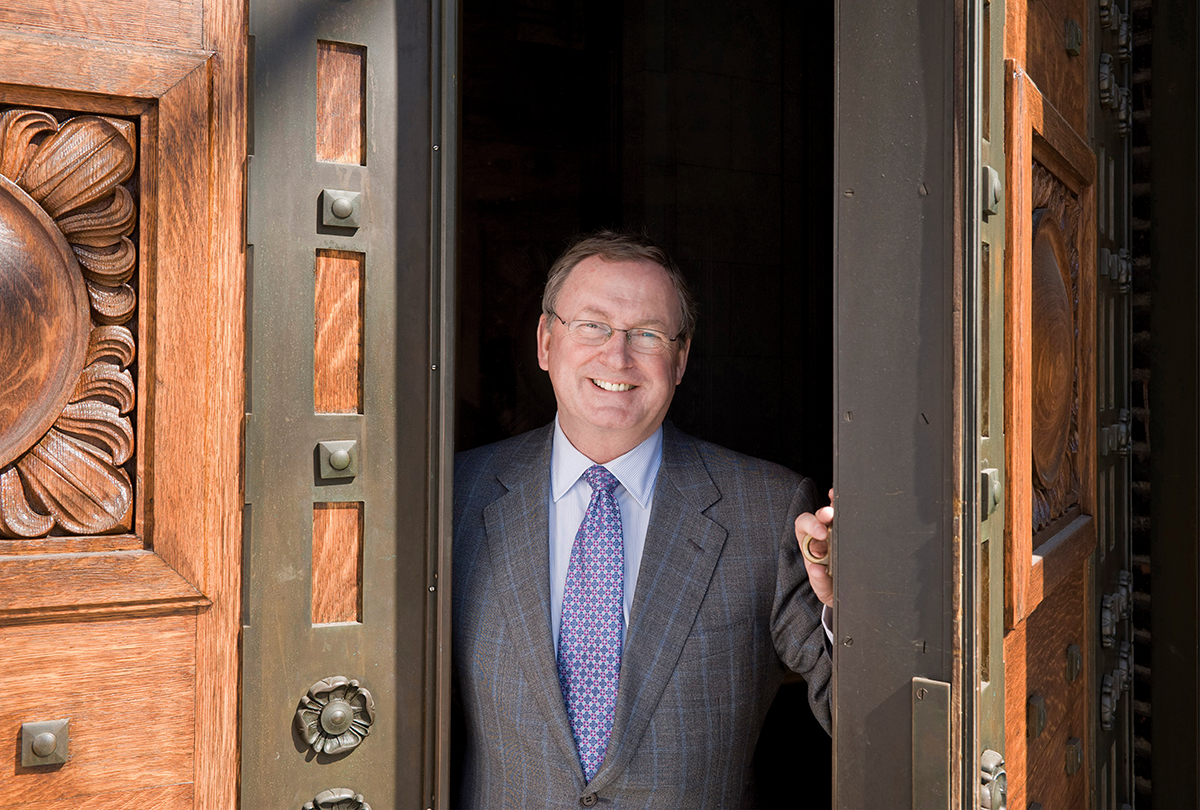Malcolm Rogers Has Left the Building

Photograph © Museum of Fine Arts, Boston
The first time I met Malcolm Rogers, he mistook me for “the trophy wife of one of the venerable trustees,” as he put it. It was June 1994 and no one was supposed to know that Rogers was on the eve of being appointed the next director of the Museum of Fine Arts. Almost nobody in America knew who he was, anyway. But rumor had it that Rogers, an Oxford-educated scholar and deputy director of London’s National Portrait Gallery, was scheduled to dine with the museum’s board of directors in the Garden Room at the Ritz-Carlton that night. Hoping to confirm his appointment, I staked out the hotel and waited.
At the appointed hour, a moon-faced gent strode up to a uniformed bellman in the hotel lobby and asked, in the Queen’s English, “Pardon, is this the lift to the Garden Room?” I scrambled into the elevator behind him. At first, Rogers was absolutely charmed that I knew who he was—but when I identified myself as a journalist, the magnetism meter went down several notches. He seemed startled and didn’t want to risk spoiling the MFA’s big announcement.
At the time, the hiring of a new director loomed large for the troubled museum, which carried a deficit of $3 million. Layoffs and retirements had depleted the already lean staff, and morale, which had been sliding for years, was subterranean. The MFA had closed its entrance on Huntington Avenue four years earlier, ostensibly as a cost-saving measure, but the move effectively sent a message that neighboring Roxbury residents were not welcome. The museum’s disgruntled security guards had organized a union, and I had recently been thrown out of one of the galleries by the vice president of security for interviewing the chief union organizer.
The MFA was not alone in its misery. As the 20th century came to an end, museums had become hulking institutions, and the requirements for a museum director had grown beyond art expertise to include fundraising skills, financial expertise, marketing savvy, diplomacy, and a showman’s combination of chutzpah and charm. A dozen other U.S. museums were also searching for new directors, and potential candidates were growing increasingly wary of the role’s changing responsibilities. Museum professionals were not exactly campaigning for the MFA’s opening, thanks to its long list of troubles. But Rogers, who had recently been passed over for the directorship at the National Portrait Gallery, lobbied unapologetically for the job. “In those days,” Rogers says, “the attitude of a Brit to a great job like the director of the MFA was that it is a prize. And I wanted to win that prize.”
The feeling was not entirely mutual. MFA trustee Ann Gund recalls asking, “Why are we interviewing this man? He is from England. He has never had any development background, and he knows nothing about Boston.” After all, Rogers was an expert on portraiture, had never held a director’s post, and had no experience at an encyclopedic museum like the MFA, where the collection ranged from internationally renowned holdings of Asian and Egyptian treasures to an enviable collection of Impressionist work. It didn’t bolster his image that he was staying at the budget-friendly Midtown Hotel on Huntington Avenue—a long distance in mindset and pedigree from the upscale Ritz-Carlton favored by the museum’s directors.
Still, Rogers blew the trustees away. “He knew exactly what was needed,’’ Gund says. At a dinner organized by the search committee, Gund was seated next to then-trustee Ted Landsmark, a prominent leader in the African-American community who is now a member of the Boston Redevelopment Authority board of directors. Rogers told the group of trustees that the first thing he wanted to do was reopen the Huntington Avenue doors, because the museum was turning its back on Roxbury. Landsmark turned to Gund and asked, “Did you put him up to this?” She hadn’t. Rogers had done his homework. He understood that the MFA needed to change.
Now, 21 years later, Rogers—who seldom shied away from publicity or controversy—has retired, leaving new director Matthew Teitelbaum an MFA that has been radically transformed. Rogers opened the museum’s doors; made strides in diversifying its collection and audience, if not its board and staff; and oversaw 102 new or renovated galleries and a refurbished building. The campus now includes a spacious new Art of the Americas Wing, the Linde Family Wing for Contemporary Art, a vast visitor center, and a high-ceilinged interior courtyard with a sleek café.
He also leaves a community deeply divided over his legacy. Rogers increased attendance and made the museum more accessible, but he did so in part by staging exhibitions that were more about flash and cash and less about artistic standards. He brought cars, guitars, and the boats of conservative billionaire Bill Koch to the museum’s lawn. He summarily fired two esteemed curators and ordered them to be escorted out of the building by uniformed guards, like rogue employees who had shared company secrets. Rogers raised $504 million for the additions to the building but is also leaving behind $140 million in debt, a little-known secret that raises questions about his financial prowess. After more than two decades at the helm of the city’s most distinguished museum, he leaves the MFA as one of the most polarizing figures the city’s insular art world has ever seen. And he also leaves a significant question in his wake: Can the MFA prosper without him?
When Rogers arrived for his first day of work in 1994, he was the 10th director to lead the museum—a storied institution that held dear to its long-entrenched values. The MFA was chartered in 1870 by a group of 12 Boston Brahmins, fellows with surnames like Eliot and Cabot. (The Metropolitan Museum of Art, in New York, was founded the same year; the Boston Symphony Orchestra wouldn’t be established for another 11 years.) City leaders gave the group a prime parcel of land in the new Back Bay neighborhood, which recently had been transformed from a muddy swamp. The founders raised money to build a red-brick terra cotta building on land that now houses the Fairmont Copley Plaza, and the original MFA opened on July 4, 1876. The largest single gift, of $25,000, came from the widow of Colonel Timothy Bigelow Lawrence, who had died unexpectedly seven years earlier on a trip to Washington, DC. It would be another 78 years before the first woman, Frannie Hallowell, was elected to the MFA board of trustees, in 1954.
Stuffiness was baked into the concept. The founders were, according to MFA archivist Maureen Melton, “men of science and men of letters” who aimed to educate and enlighten the public. There was, of course, a bit of noblesse oblige involved. The upper classes in the U.S. were frightened by waves of immigration from Ireland and southern and eastern Europe, and they viewed cultural institutions as civilizing agents. “It was fairly Puritanical,’’ says Alan Wallach, professor emeritus of art and art history at William & Mary College. “They wanted to sponsor institutions that were educational, not simply for aesthetic or sensual pleasure.”
The MFA eventually outgrew its headquarters in Copley Square, and the trustees bought the 12 acres of land where the museum now sits—at the time, it was a rental ground for circuses and rodeos. The Beaux Arts building, designed by Guy Lowell, opened in 1909. The museum’s more than 110,000 objects were moved from Copley Square by horse and cart.
From 1918 to 1966, the MFA offered free admission every day. During the Depression, it became a haven for folks who came not just for the art, but also for the warmth. The museum’s Brahmin trustees referred to the unemployed as “people suffering enforced leisure,” Melton says. The MFA’s visitors may have been changing, but its board members weren’t. “Fundamentally, you were looking at the same kinds of trustees,” Melton adds. “Many were still drawn from that same sort of white Protestant male.”
The MFA remained a sleepy temple of art until the postwar period, when there was a huge upsurge in college education and more people were fluent in art history. Museums suddenly began focusing on visitor services. Perry T. Rathbone, who was appointed director in 1955, ushered the MFA into the blockbuster era, staging crowd-pleasing exhibitions of works by Rembrandt, Cézanne, and Matisse. He eventually resigned in 1972 after a scandal involving the acquisition of a dubious Raphael, but by then he’d thoroughly shaken the place up. A showman known for his publicity stunts and his ability to work the crowd, Rathbone also added new blood to the board that was considerably less blue. His daughter, author Belinda Rathbone, notes that her father was compared to another guy with the initials P.T.—the one whose last name was Barnum. Similar claims have been made about Rogers, whose populist approach to exhibitions at times recalled the location’s former use as a circus ground.


